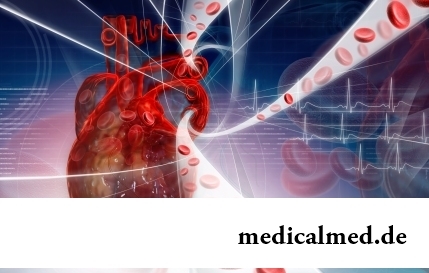





Renal artery
Renal artery – the pair terminal blood vessel departing from side surfaces of a ventral aorta and supplying with blood a kidney. Renal arteries bring blood in apical (apical), back, lower and front kidney segments. Only 10% of blood go to kidney marrow, and the most part (90%) – to cortical substance.

Structure of a renal artery
There are right and left renal arteries, each of which is divided into back and front branches, and they are in turn divided into segmented branches.
Segmented branches branch on interlobar branches which break up to the vascular grid consisting of arc arteries. Interlobular and cortical arteries, and also medullary branches from which blood arrives to shares (pyramids) of a kidney depart from arc arteries to the renal capsule. Everything together they form arches from which the bringing vessels depart. Each bringing vessel branches on the ball of capillaries captured by the capsule of a ball and the basis of a renal tubule.
The efferent artery also breaks up to capillaries. Capillaries braid tubules of kidneys, and then pass into veins.
The right artery from an aorta lies forward and directly, and then goes to a kidney, slantwise and down, behind the lower vena cava. The way of the left artery to hiluses renalis is much shorter. It moves in the horizontal direction and behind the left renal vein falls into a left kidney.
Stenosis of renal arteries
Stenosis call partial occlusion of an artery or its leading branchs. The stenosis develops as a result of an inflammation or a prelum of an artery a tumor, a dysplasia or atherosclerotic narrowing of a vessel. Fibromuscular a dysplasia represent group of damages at which there is a thickening of average, internal or subadventitious covers of a vessel.
At a stenosis of renal arteries work of a kidney because of its defective supply with blood is broken. Dysfunction of a kidney quite often leads to development of a renal failure. The stenosis of renal arteries is sometimes shown in sharp increase in the ABP. But most often this disease proceeds asymptomatically. The long stenosis of arteries can lead to an azotemia. The azotemia is shown in confusion of consciousness, weakness, fatigue.
Existence of a stenosis is usually defined by the KT-angiography, doppler sonography, by urofragiya, arteriography. In addition for identification of causes of illness carry out the analysis of urine, biochemical and general blood tests, define concentration of electrolytes.
For pressure decrease at a stenosis the combination of anti-hypertensive medicines with diuretics is usually appointed. When narrowing a gleam of a vessel more than for 75% apply surgical methods of treatment - balloon angioplasty, stenting.
Denervation of renal arteries
Endovascular surgeons apply a method of catheter sympathetic denervation of renal arteries to achievement of lasting anti-hypertensive effect.
Denervation of renal arteries – an effective anemic technique of treatment of a resistant hypertension. During the procedure to the patient enter a catheter which gets into arteries into a femoral artery. Then under a short-term anesthesia carry out radio-frequency cauterization of mouths of arteries from within. Cauterization destroys communication of esodic and efferent sympathetic nerves of arteries with a nervous system that leads to weakening of influence of kidneys on indicators of blood pressure. After cauterization the conductor is taken, and the place of a puncture of a femoral artery is closed by the special device.
After denervation there is a stable lowering of arterial pressure on 30–40 mm of mercury. for a year.
Thrombosis of a renal artery
Thrombosis of a renal artery – overlapping of a renal blood-groove the blood clot which came off extrarenal vessels. Thrombosis arises at an inflammation, atherosclerosis, an injury. In 20-30% of cases of fibrinferments happens bilateral.
At fibrinferment of a renal artery there is acute and severe pain in a waist, a kidney, in a back which extends in a stomach and sideways.
Besides, thrombosis can serve as the reason of sudden substantial increase of blood pressure. Very often at fibrinferment there is nausea, vomiting, a lock, body temperature increases.
Treatment of thrombosis complex: anticoagulating treatment and symptomatic therapy, surgical intervention.
Aneurism of a renal artery
Aneurism of a renal artery is a sacculate expansion of a gleam of a vessel due to existence in its wall of elastic fibers and absence muscular. Aneurism most often happens unilateral. It can be placed both intrarenalno, and ekstrarenalno. Clinically this pathology can be shown by a thromboembolism of vessels and arterial hypertension.
At aneurism of a renal artery operation is shown. There are 3 types of operation of this type of anomaly:
- artery resection;
- excision of aneurism with substitution of its defect a patch;
- anevrizmografiya – sewing up of an arterial wall the aneurism fabrics left after preliminary excision of its main part.
Anevrizmografiya is applied at multiple defeats of a vessel and aneurism of the big sizes.
According to WHO researches the daily half-hour conversation by the mobile phone increases probability of development of a tumor of a brain by 40%.

Dogrose – one of the most widespread adornment and medicinal plants growing practically in all territory ours...
Section: Articles about health
According to doctors, more than a half of men of 25-50 years suffer from frustration of the urinogenital sphere, but the minority sees a doctor from them. And in vain - even the insignificant discomfort in the field of generative organs can serve as a symptom of an illness fraught heavy посл...
Section: Articles about health
Helminthosis is one of the most widespread diseases. Statistically, any species of helminths infected every third inhabitant of the planet. Most of specialists even consider these data strongly underestimated: some uninvited "cohabitants" do not cause the carriers serious troubles, and patients just do not see doctors. The situation is aggravated also with the fact that people know about specifics of similar illnesses very little. At many presence of worms is strong ассоциир...
Section: Articles about health
What woman does not dream of a beautiful and thick hair? So far physicians developed difficult schemes on hair transplant, in the bet industry...
Section: Articles about health
The phenomenon of the panic attack is known long ago, but the reasons of its emergence still are up to the end not found out. It is established that more than 30% of people at least once in life become the victims of very unpleasant phenomenon: without everyones on that the reasons they have a feeling of horror, with...
Section: Articles about health
Dietary supplements (dietary supplements) for the last decades were so thoroughly included into our life that, apparently, it is already impossible to find the person who at least once did not try them. At the same time, most of our compatriots have a vague idea of what dietary supplements as they affect a human body consist of and what differ from the real medicines in. Let's try to understand these questions, and at the same time and to understand, such additives are how necessary for us....
Section: Articles about health
Household skills which to us so diligently imparted in the childhood it appears, not always bring only benefit. According to result...
Section: Articles about health
Smack in a mouth can arise in the natural way – as a result of lack of morning hygiene or reception of the corresponding food. However in certain cases its existence is a sign of certain pathologies, and allows to reveal an illness at an early stage. In we depend...
Section: Articles about health
Traveling all over the world, many try to try the most exotic dishes of national cuisines. There is even a so-called gastronomic tourism which, according to gourmets, not only allows to receive new feelings, but also is capable to show life of other people from absolutely unexpected side....
Section: Articles about health
Coffee - the tonic loved by many for the invigorating aroma and deep taste. Having the stimulating effect, coffee raises ра...
Section: Articles about health
The body of the person almost for 60% consists of water. It is so important for normal functioning of an organism that loss of only one and a half percent of liquid already leads to the most unpleasant effects. The problems connected with deficit of water can overtake and...
Section: Articles about health
The state of health of the person in many respects depends on chemical composition of biological liquids of an organism. Specialists consider that PH value of these solutions has to be in range of 7,35-7, 45. The deviation in the smaller party (so-called "acidulation") is fraught with development of many heavy illnesses, failures in work of immune system, decrease in working capacity and deterioration of life. To avoid serious fluctuations of acidity of internal liquids it is necessary to adhere разумног...
Section: Articles about health
Food with the increased content of sugar is attractive to most of people - it is scientifically confirmed fact. Business here not in a nevozder...
Section: Articles about health
Aspirin (acetylsalicylic acid) – one of those drugs which are known literally to all. It is available in each home first-aid kit, and many accept it at the first signs of an indisposition, often without having a fair idea of properties and a therapeutic eff...
Section: Articles about health
Life of the modern woman is very difficult. Opportunities to realize itself are wide: it not only education and career, but also the most various hobbies from sport before needlework. It is not less important to build private life, paying an attention maximum to children, the husband, parents, friends. For all these affairs there is catastrophically not enough time therefore each of us tries to cut down as far as possible its expenses on necessary, but not the most fascinating housework. With it we are successfully helped by means...
Section: Articles about health
The dietology, as well as other sciences, does not stand still. Food stuffs are exposed to comprehensive study, and scientists receive new and...
Section: Articles about health
The name of this disease precisely reflects the problem reason: it consists in the bra fastener pressure upon a certain zone of a back. At the same time one of vertebrae of chest department of a backbone is as if blocked and loses mobility, and falling on it is nude...
Section: Articles about health
From sexual contacts each person can test insufficiently strongly expressed sexual desire or lack of satisfaction from time to time. However when it happens regularly, it is an occasion to think about health. Most of people does not hurry to ask similar questions physicians: one consider that they will be able to cope with malfunctions independently, others hesitate to report to strangers about so delicate problems and hope that troubles will stop by itself....
Section: Articles about health
Proofs of efficiency of Mildronate at treatment of coronary heart disease with stenocardia can be found in many publications to...
Section: Articles about health
Almost each of us during life faced dissatisfaction with own body. At such moments, as a rule, we begin to shame ourselves, urgently we go on the most rigid diet promising minus of 10 kg in a week, or we exhaust ourselves in the gym to полусм...
Section: Articles about health
During foot walks blood moves on vessels more actively and one and all bodies are supplied with a large amount of oxygen. It affects the state of health of the person very positively....
Section: Slideshow
Urogenital candidiasis (milkwoman) – a fungal infection which annoys unpleasant feelings in the field of generative organs, сопр...
Section: Articles about health
One of the useful properties presented to the person by the nature is ability to feel fear. This ability is designed to signal about approach of a dangerous situation and to help to avoid in advance it to keep life. However if the fear is persuasive and not about...
Section: Articles about health
The hysteromyoma is diagnosed more than at a third of women 35 years are more senior. This high-quality new growth which at early stages successfully resolves by means of medicines. It is necessary to resort to an operative measure only when patients too late address specialists, or therapeutic methods do not give the expected effect because of specific features of an organism. Besides, there is a large number of quite effective national...
Section: Articles about health
Venereal diseases in medicine are called the infections which are transmitted preferential sexually, now they are so...
Section: Articles about health
The phenomenon of improvement of a condition of the patients at administration of drugs who are not containing active agents, so-called effect of placebo is known long ago. At the end of the 18th century the American doctor Perkins began to treat people the "miracle" sticks made of a spl...
Section: Articles about health
Smoking not only exerts a negative impact on the state of health of the consumer of tobacco products, but is an air polluter the substances potentially dangerous to people around. In recent years significantly the number of the people aiming to get rid of an addiction increased. Business this difficult: having left off smoking, the person immediately begins to suffer from abstinence. Besides, many yesterday's smokers feel at first great disappointment as улучш...
Section: Articles about health
